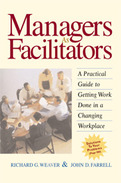Managers as Facilitators
John D. Farrell (Author)
Publication date: 12/28/1998
Bestseller over 35,000+ copies sold
Today's managers are confronted with increasing pressure to produce more with fewer resources. In this pressure-packed environment, managers are finding that the old "direct-and-control" model simply does not work. People need more freedom to make decisions, respond quickly to their customers, and work together more effectively. Successful managers have learned how to use the role of facilitator to help people exercise this freedom to produce the results needed by their organizations.
Managers As Facilitators presents a new, easy-to-understand model of facilitation that focuses on getting work done. It provides practical guidance for managers and leaders who need to be successful in this new role. Weaver and Farrell show managers how to use themselves in new ways, capitalize on group dynamics, and build effective work processes. They explain that to become a successful facilitator, one must recognize and use the four key elements of the facilitation model:
1. Task: Facilitators are clear about the work that groups must complete; task drives the actions of effective facilitators.
2. Self: Facilitators learn how to use themselves to help groups complete their tasks; facilitators do this by both using their own personal thoughts and feelings as a "barometer" for groups and modeling the types of behavior expected from others.
3. Group: Facilitators help groups understand the difference between normal interactions and those that are a problem; facilitators also help groups capitalize on conflict, rather than be disabled by it.
4. Process: Facilitators use three fundamental processes to help groups: planning, solving problems, and completing work; facilitators are skilled with a number of facilitation tools, using them to help groups run effective meetings, finish projects, etc.
Managers As Facilitators offers readers practical ways to manage change and organizational boundaries to achieve the results they want. The authors explain how individuals, groups, and organizations experience change and work with boundaries-and what facilitators do to help. The book's final chapter synthesizes all the material by presenting "Quick Fixes" to common problems.
- Offers a practical, effective program to help transform leaders and managers in all types of organizations into skilled facilitators
- Teaches managers the facilitation skills they need to help their organizations improve productivity
- Includes real-life examples from manufacturing, telecommunications, health care, education, retail and other service businesses, and government and other non-profit organizations
Find out more about our Bulk Buyer Program
- 10-49: 20% discount
- 50-99: 35% discount
- 100-999: 38% discount
- 1000-1999: 40% discount
- 2000+ Contact Leslie Davis ( [email protected] )
Today's managers are confronted with increasing pressure to produce more with fewer resources. In this pressure-packed environment, managers are finding that the old "direct-and-control" model simply does not work. People need more freedom to make decisions, respond quickly to their customers, and work together more effectively. Successful managers have learned how to use the role of facilitator to help people exercise this freedom to produce the results needed by their organizations.
Managers As Facilitators presents a new, easy-to-understand model of facilitation that focuses on getting work done. It provides practical guidance for managers and leaders who need to be successful in this new role. Weaver and Farrell show managers how to use themselves in new ways, capitalize on group dynamics, and build effective work processes. They explain that to become a successful facilitator, one must recognize and use the four key elements of the facilitation model:
1. Task: Facilitators are clear about the work that groups must complete; task drives the actions of effective facilitators.
2. Self: Facilitators learn how to use themselves to help groups complete their tasks; facilitators do this by both using their own personal thoughts and feelings as a "barometer" for groups and modeling the types of behavior expected from others.
3. Group: Facilitators help groups understand the difference between normal interactions and those that are a problem; facilitators also help groups capitalize on conflict, rather than be disabled by it.
4. Process: Facilitators use three fundamental processes to help groups: planning, solving problems, and completing work; facilitators are skilled with a number of facilitation tools, using them to help groups run effective meetings, finish projects, etc.
Managers As Facilitators offers readers practical ways to manage change and organizational boundaries to achieve the results they want. The authors explain how individuals, groups, and organizations experience change and work with boundaries-and what facilitators do to help. The book's final chapter synthesizes all the material by presenting "Quick Fixes" to common problems.
- Offers a practical, effective program to help transform leaders and managers in all types of organizations into skilled facilitators
- Teaches managers the facilitation skills they need to help their organizations improve productivity
- Includes real-life examples from manufacturing, telecommunications, health care, education, retail and other service businesses, and government and other non-profit organizations














